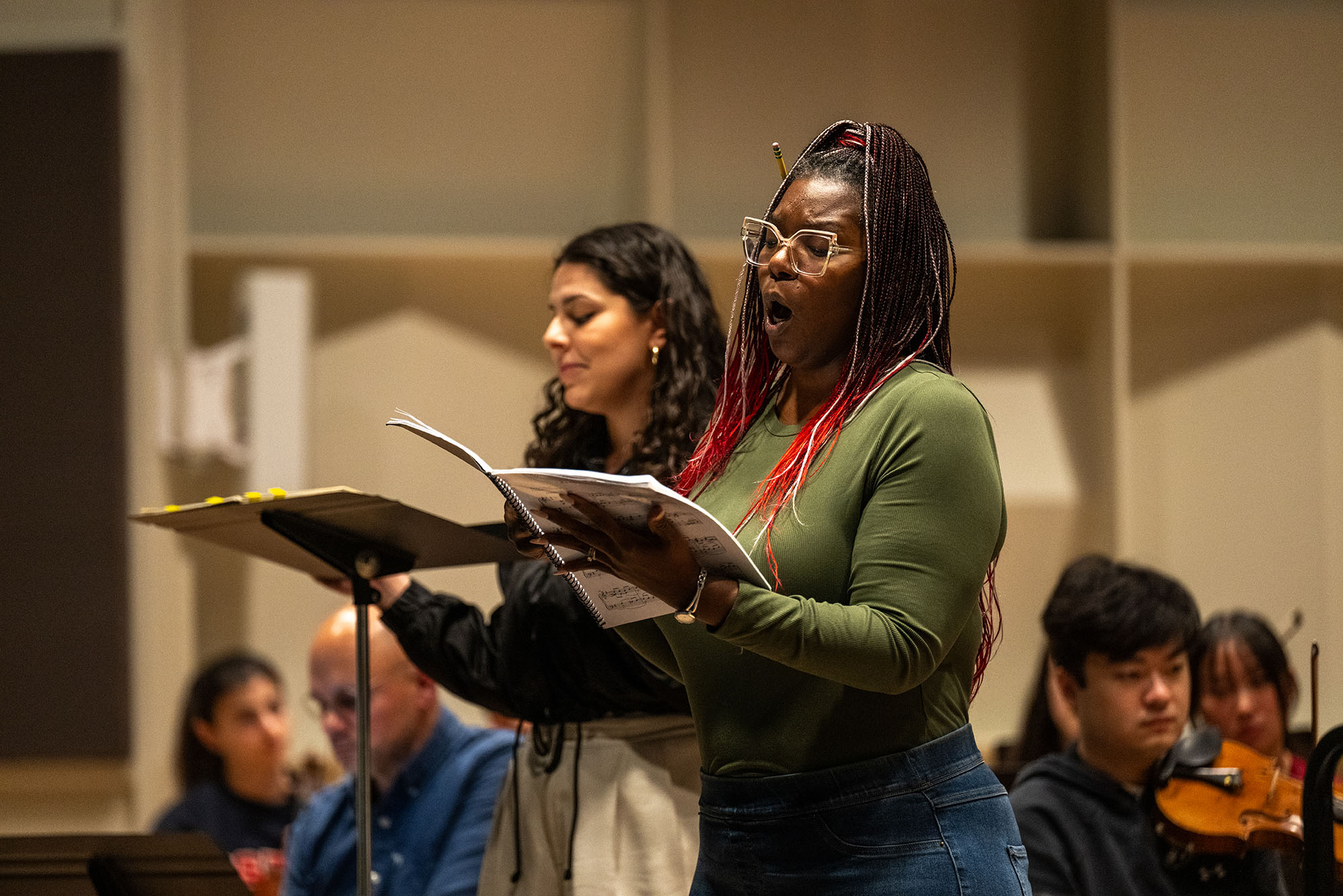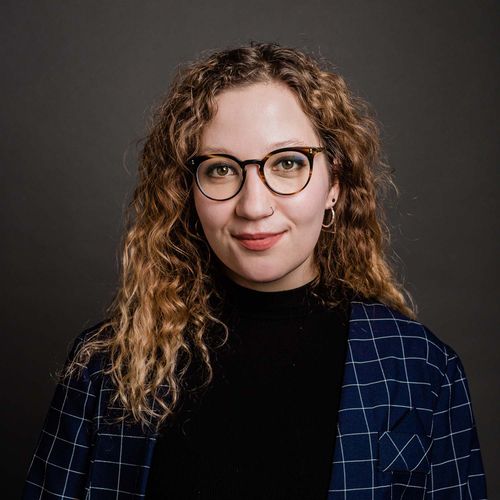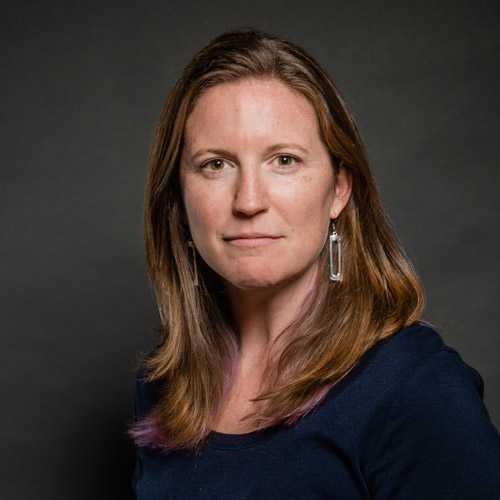How a BU Researcher Found and Revived a Long-Lost Operatic Masterpiece
Cuban composer Eduardo Sánchez de Fuentes’ opera El Caminante, rediscovered after more than a century, had its world (re)premiere at Boston University

David Guzmán (center) rediscovered Eduardo Sánchez de Fuentes’ El Caminante—and performed in its revival performance. Here, he rehearses with BU’s Symphony Orchestra, alongside mezzo-soprano Juliette Kaoudji (CFA’26) (left) and soprano Michelle Johnson (CFA’07) (right).
How a BU Researcher Found and Revived a Long-Lost Operatic Masterpiece
Cuban composer Eduardo Sánchez de Fuentes’ opera El Caminante, rediscovered after more than a century, had its world (re)premiere at Boston University
El Caminante, a long-forgotten Cuban opera, opens with a swell of sweeping, almost mournful strings. The music is evocative of some of the most iconic 20th-century scores (think Leonard Bernstein or Rodgers and Hammerstein)—so much so that you almost expect to hear the crackle of film underneath the soundscape. As the orchestra picks up the tempo, it’s hard to believe this music hasn’t been heard in over a century—that it lay forgotten until rediscovered and revitalized by a Boston University College of Fine Arts researcher.
Flutes trill above the rest of the music. Every once in a while, a Latin beat catches your ear. By the time the main vocalists come in, their soprano and mezzo-soprano weaving seamlessly around one another, it hits you: what you’re listening to is a masterpiece.
El Caminante premiered in Cuba in 1921. The one-act Spanish-language opera was one of five written by Cuban composer and author Eduardo Sánchez de Fuentes. Unfortunately, the work was lost to history. Or it was, until David Guzmán, a BU College of Fine Arts assistant professor of music, voice, uncovered the piano-vocal score in Harvard University’s archives in 2020. Operas have two main scores: the piano and vocal score—sometimes referred to as the songbook—used for facilitating rehearsals, and the orchestral score, used for performances. Guzmán found the orchestral score in Cuba three years later.
This November, after 100 years hidden in the dark, the opera had its world (re)premiere, this time at BU’s Tsai Performance Center.
“The book was amazing,” says Guzmán, an opera tenor. “The music was so clever and well-written. But when I found the score, it just opened a world of possibilities with this opera.”
The Story of the Traveler
El Caminante, which means “the traveler,” is based on a poem and theatrical production by Francisco Villaespesa called “Era Él,” meaning “it was him.”
The opera tells the story of a girl, Yolanda, and her mother, Ginesa, both devout Catholics. Yolanda has lost the ability to walk, and now her mother spends her days searching for help for her daughter’s condition. All the while, Yolanda dreams of a mysterious stranger coming to heal her. Mother and daughter pray to Jesus for a miracle—and one is sent to them in the form of a caminante, who comes to them seeking water for his journey. Struck by Yolanda’s beauty, the caminante embraces and kisses her. Suddenly, she realizes that she can walk again—and that the caminante was the stranger she was dreaming about all along. The caminante leaves, and the opera ends.
“It’s a really hopeful story,” Guzmán says. “The caminante allows Yolanda to feel beautiful, and her healing comes from how she feels within. It’s a reminder that, so often, the healing we seek lies inside of us—in how we process our emotions, navigate daily challenges, and manage stress.”
It’s also a story about love. Beyond the mother and daughter relationship, the traveler is meant to be a representation of love, he says. And, unlike many operas, “nobody dies!” Guzmán points out, laughing. “The world needs to see that; not many operas talk about love without tragedy.”
Finding El Caminante
Guzmán first stumbled across Sánchez de Fuentes in 2017 when researching for a dissertation on Latin American art songs, vocal compositions written with piano accompaniment.
“I found this battered score of art songs by Eduardo Sánchez de Fuentes, and the music was beautiful: the poetry, the melodic line, and piano writing were all incredible,” Guzmán says. “But his name was unfamiliar to me. I was intrigued.”
So began his deep dive into Sánchez de Fuentes’ life and works. Born in Havana in 1874, then a Spanish colony, Sánchez de Fuentes showed musical prowess from a young age, and studied with European-trained musicians. In addition to his operas, he wrote seven zarzuelas, popular Spanish plays with musical components; one oratorio, a grand musical composition with religious themes; and more than 100 songs. One of his most famous works is a song called “Tú,” a love letter to Cuba that he wrote at 18. (Listen to Guzmán’s album of Latin American art songs, including four songs by Sánchez de Fuentes, here.)
Guzmán found plenty of mentions of Sánchez de Fuentes’ works. But he couldn’t find any published scores—which had become his mission. Eventually, his research led him to a press clipping praising a performance of the opera El Caminante at Havana’s Teatro Tacón, then called the Gran Teatro de La Habana, on June 17, 1921. The titular role was sung by Italian Tito Schipa, one of the most celebrated tenors of the time.

“That was a big ‘wow’ for me—Schipa was the [Luciano] Pavarotti of that era,” Guzmán says. He knew he needed to find that score.
His multiyear search ended during the height of COVID-19 lockdowns in 2020, after he arrived at BU. Libraries had started to digitize their archives and make them available to the public. One afternoon, after teaching on Zoom, he decided to Google “El Caminante opera” one last time. It paid off: the search yielded a PDF of the original handwritten vocal and piano score in Harvard’s archives. “It was just unbelievable,” Guzmán says.
He traveled to Cuba in 2023 in the hopes of learning more about Sánchez de Fuentes and uncovering the rest of the score. He found all of the composer’s songs in the National Library of Havana and the scores in the Museo Nacional de la Música.
However, he still needed the opera’s libretto—the text that also contains the lyrics—plus any spoken dialogue, staging details, prop and scenery descriptions, and more. Once he realized that the vocal score was based on Villaespesa’s “Era Él,” Guzmán was able to track down the original poem, which Villaespesa wrote as a dramatic production. Guzmán incorporated Villaespesa’s performance instructions into El Caminante’s piano-vocal score, creating a new libretto for the opera.
By then, the BU Opera Institute had already workshopped El Caminante in classes. As soon as Guzmán had the orchestral score—which like the piano-vocal score, he edited for clarity—and a libretto, he knew a performance was in order.
El Caminante was brought to life with help from a trio of CFA faculty: William Lumpkin, an associate professor of music and the artistic director and conductor of BU’s Opera Institute; Allison Voth, an associate professor of music and principal coach for the Opera Institute; and Oshin Gregorian, managing director of the Opera Institute and CFA’s opera programs.

Their efforts resulted in a concert-style performance (not a staged dramatic production) with BU’s Symphony Orchestra, conducted by Lumpkin. Guzmán sang the titular tenor role, with CFA alum and opera star Michelle Johnson (CFA’07) as Yolanda (lead soprano) and performance diploma student Juliette Kaoudji (CFA’26) as Ginesa (mezzo-soprano). Opera Institute students sang the ensemble parts. The performance was recorded.
“As they say, it takes a village,” Guzmán says. “This was a huge effort—I really have to extend my gratitude to everyone who worked to make this possible.”
The Future of El Caminante
Guzmán has long studied Spanish and Latin American music. When it comes to opera, he says, Spanish-language works have been sidelined for generations. The great European composers Puccini, Verdi, and Wagner—whose works are largely in Italian—dominated the landscape while Sánchez de Fuentes was alive. And they still do: if you were to ask someone to name an opera, it’s likely that they’d name a work penned by one of the three. But Guzmán says Spanish-language composers—like Sánchez de Fuentes—who were influenced by the greats, but brought their distinct cultural styles to the genre, also deserve recognition.
“I think it’s important for us to revive these pieces to not only do justice to them,” he says, but also to find out what it would have been like if Spanish operas had been as celebrated as their Italian counterparts.
After spending the past century hidden from view, El Caminante is destined for a more public future. The recording of the November performance will drop in the new year. The Universidad Complutense de Madrid, Spain, will publish both El Caminante scores. Guzmán’s collaborator Álvaro Torrente, a Spanish musicologist and publisher, plans to pitch a production to Madrid’s Teatro Real, one of the most renowned opera houses in Europe. As a one-act opera with few characters, it’s a relatively simple production to stage, Guzmán explains; an opera house would most likely pair it with other shorter works.
“It’s going to be a beautiful day if that happens,” Guzmán says.
“This is the beginning of the story of El Caminante,” he adds. “The scores will be printed and be accessible to anybody, and we’ll have audio and video. This is a dream come true.”
He also wants people to know that opera doesn’t have to be intimidating.
“People think that you have to have previous knowledge to go to the theater and enjoy opera, but I think that’s wrong,” Guzmán says. “Opera is nothing but story set to acoustic music. And it doesn’t matter what language a production might be in, because there are subtitles at every theater now.
“Once you go to a theater and feel the sound of a voice and a whole orchestra washing over you—that’s something you can’t put into words. It’s an experience everyone needs to feel for themselves.”


Comments & Discussion
Boston University moderates comments to facilitate an informed, substantive, civil conversation. Abusive, profane, self-promotional, misleading, incoherent or off-topic comments will be rejected. Moderators are staffed during regular business hours (EST) and can only accept comments written in English. Statistics or facts must include a citation or a link to the citation.